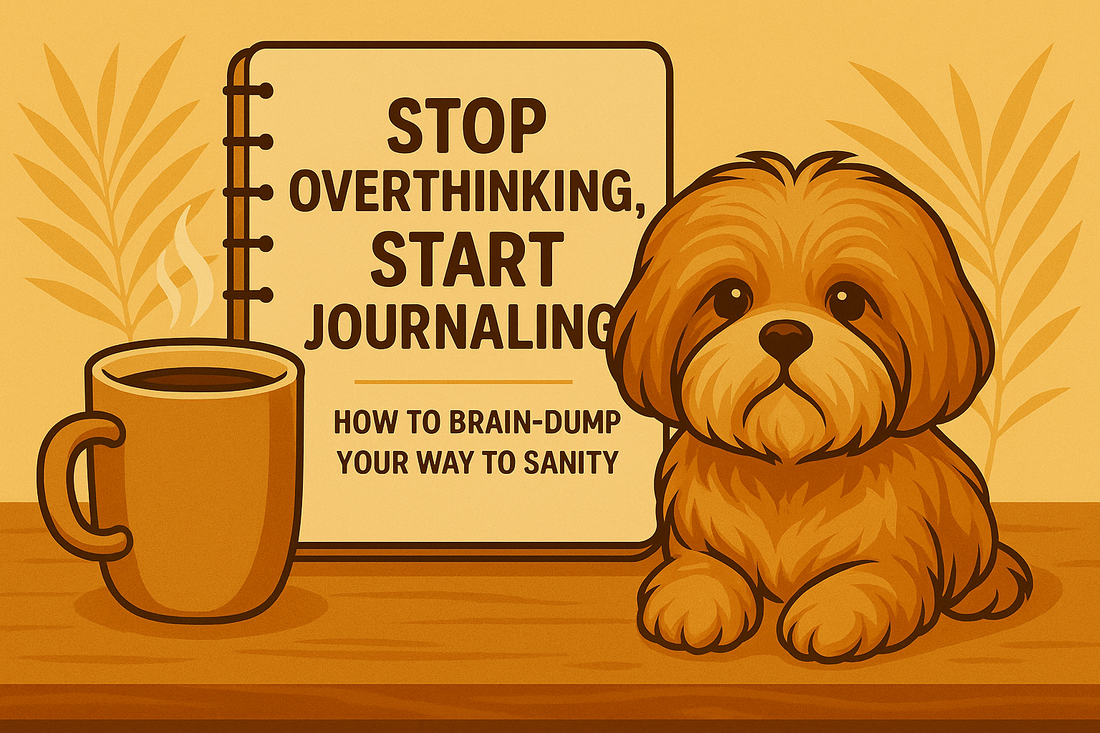
Stop Overthinking, Start Journaling: How to Brain-Dump Your Way to Sanity
Share
Welcome to the official chaos club—where thoughts spiral faster than your WiFi in a thunderstorm and to-do lists multiply like gremlins after midnight. Overthinking is the unofficial national pastime of stressed-out, goal-chasing humans. But you, dear reader, are holding the antidote in your hand—or at least, you’re about to.
Enter the brain dump journal, your new best friend, therapist, and permission slip to get everything out of your head and onto paper. No filters. No rules. Just glorious, unfiltered truth scribbled across a page designed to finally give your brain a break.
Let’s dive into what brain dumping really is, how to do it (without making it complicated), and why stress relief writing is a total game-changer for your mental wellness—and your daily productivity.
What Is a Brain Dump Journal (And Why Do You Need One, Like, Yesterday)?
Let’s keep it simple: a brain dump journal is a judgment-free zone where you unload everything swirling around in your mind. Think: the thoughts you forgot to finish, the anxiety about emails you haven’t answered, your grocery list, your existential dread, and your big ideas for reinventing the snack drawer.
It’s part diary, part planner, part stress relief tool—and all yours.
Unlike traditional journaling, which might focus on reflection, gratitude, or storytelling, brain dumping is raw, messy, and deliciously unfiltered. You don’t need perfect grammar. You don’t need a plan. You just need a pen, a quiet(ish) moment, and the willingness to let your thoughts hit the page as they come.
Why it works:
- You give your brain permission to not remember everything.
- You create space for new ideas and emotional clarity.
- You move from mental chaos to written organization—even if it’s scribbles.
The goal? Sanity. Or at least enough peace to make it to bedtime without screaming into a pillow.
The Mental Benefits of Stress Relief Writing
Before you dismiss this as another cute self-care trend (alongside crystal water bottles and adult coloring books), let’s talk science.
When you write down your thoughts—especially overwhelming, disorganized ones—you:
- Reduce cognitive load (a fancy way of saying “stop overloading your mental RAM”)
- Lower cortisol (yes, the stress hormone)
- Improve sleep (especially if you do a brain dump before bed)
- Gain perspective on problems that felt huge when trapped inside your mind
Writing is a form of externalizing. You stop holding your thoughts hostage inside your skull and give them a home on the page. This simple action helps you feel seen—by yourself. And that’s a wildly underrated feeling.
How to Start a Brain Dump Journal (Without Overthinking It)
Ready to do the mental equivalent of emptying your email inbox? Here’s how to start your own brain dump journal—even if you’ve never journaled a day in your life.
1. Grab a Dedicated Journal
You could brain dump on napkins or the back of receipts, but let’s be real—you deserve better. Our journal collection is full of spiral-bound beauties made for chaotic minds. If you need a nudge, the "Chaos Journal" was literally made for this.
Choose a journal that feels inviting—whether that’s minimalist and clean or bursting with color and sass.
2. Set a Timer (Optional but Powerful)
Feeling resistance? Set a 5-minute timer. Tell yourself: “I’ll write whatever comes to mind until the buzzer.” No editing. No backspacing. Just flow.
More often than not, once you start, you’ll want to keep going.
3. Dump It All—Messy Is Welcome
Write down:
- Everything you’re worried about
- What’s on your mind for the day
- Random ideas or tasks
- Conversations you’re replaying
- Feelings that don’t have a place elsewhere
There’s no structure needed. Think of it like decluttering your mental junk drawer.
4. Pause. Breathe. Re-Read (If You Want)
Some days you’ll want to read back what you wrote and make sense of it. Other days you’ll close the journal and never look again. Both are valid. Trust your gut.
Real-Life Brain Dump Scenarios (Because We’ve All Been There)
Sunday Scaries Incoming:
Write down everything you think you need to do this week. Chances are, half of it can be postponed or isn’t even real. Instant clarity.
Decision Fatigue at 2 PM:
Brain dump your pros, cons, and spirals. Seeing it on paper often reveals the right answer.
Spinning at Bedtime:
Write a quick “thought unload” before bed. You’ll sleep better—no more arguing with yourself in the dark.
Creative Block:
Dump your bad ideas first. Your good ones are just hiding behind them.
Emotional Overload:
Angry? Sad? Irritated by someone breathing too loudly? Let it out on paper instead of starting a group chat war.
Brain Dump Prompts (For When You’re Stuck)
Sometimes your brain feels full, but you don’t know what to write. That’s okay. Try these jumpstarts:
- “Right now I’m thinking about…”
- “I can’t stop worrying about…”
- “Today felt like…”
- “If I could press pause on one thing, it would be…”
- “I need to let go of…”
Still not flowing? Just write “I don’t know what to write” ten times. Something will follow. Promise.
Tips to Make It a Habit (That You’ll Actually Look Forward To)
You don’t have to do this every day. But you can. Here’s how to make it stick:
- Leave your journal out in plain sight—make it part of your space.
- Tie it to another habit (coffee, bedtime, skincare, etc.).
- Give yourself permission to be brief. Even one messy paragraph counts.
- Use fun pens, stickers, or washi tape if that makes you happy.
- Celebrate consistency over perfection. You’re not writing a memoir. You’re making mental space.
Why the Brain Dump Journal Belongs in Every Bag, Desk, and Nightstand
Here’s the truth: the world isn’t getting less chaotic. But you can become more grounded. More in control. More yourself.
Journaling isn’t a trend—it’s a tool. One that has survived centuries for a reason. And the brain dump journal is your gateway into a version of journaling that asks nothing of you but your honesty.
At Dual Threads, we don’t believe in perfect pages. We believe in real ones. So scribble. Doodle. Write sideways if you must. Just get it out.
Your brain deserves a break. Give it one.
FAQ: Brain Dump Journal Edition
Q: What’s the difference between a brain dump and regular journaling?
A: Regular journaling often follows a theme—gratitude, reflection, storytelling. Brain dumping is chaotic by design. It’s about mental offloading, not polished entries.
Q: How often should I brain dump?
A: Whenever your brain feels too full. For some, that’s daily. For others, a few times a week does the trick. Let your mental state be your guide.
Q: Can I type my brain dump instead of handwriting it?
A: You can, but studies show handwriting is more therapeutic for stress relief. That said, done is better than perfect—if digital works for you, go for it.
Q: What if my thoughts feel too dark or negative to write down?
A: That’s exactly why this practice exists. No one else will read it. There is power in naming your feelings without judgment. If it feels overwhelming, consider talking to a mental health professional, too.
Q: What should I do with my brain dumps afterward?
A: Totally up to you. Some people re-read and organize them. Others never look again. There’s no rule here—do what feels right.
Ready to Brain Dump Your Way to Sanity?
Overthinking is exhausting. But it doesn’t have to run the show. Grab a journal that makes you smile, set a timer, and let it out. Whether it’s your first brain dump or your fiftieth, your mind will thank you.
Still swirling in thoughts? Check out the Chaos Journal blog for more writing prompts, real-talk journaling advice, and notebook therapy straight from fellow scribblers who get it.
Your next best idea, biggest breakthrough, or “wow, I didn’t realize I felt that way” moment is waiting on the page.
So what are you waiting for? Go dump that brain. 🧠✍️
